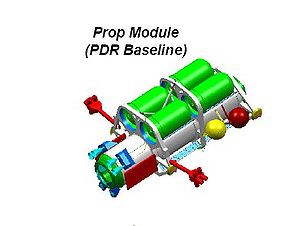
ISS Propulsion Module
Encyclopedia

Navigation
Navigation is the process of monitoring and controlling the movement of a craft or vehicle from one place to another. It is also the term of art used for the specialized knowledge used by navigators to perform navigation tasks...
, control and propulsion are provided only by Russian (Zvezda and Progress) and future European (ATV
Automated Transfer Vehicle
The Automated Transfer Vehicle or ATV is an expendable, unmanned resupply spacecraft developed by the European Space Agency . ATVs are designed to supply the International Space Station with propellant, water, air, payload and experiments...
) assets. A Propulsion Module would have been needed for ISS altitude maintenance and reboost, debris avoidance maneuvers, attitude control and propellant supply in the event the Zvezda Service Module was not available (launch failure, etc.) to the International Space Station
International Space Station
The International Space Station is a habitable, artificial satellite in low Earth orbit. The ISS follows the Salyut, Almaz, Cosmos, Skylab, and Mir space stations, as the 11th space station launched, not including the Genesis I and II prototypes...
. If the Zvezda had not been available, the Interim Control Module
Interim Control Module
The Interim Control Module is a NASA constructed module designed to serve as a temporary "tug" for the International Space Station in case the Zvezda service module was destroyed or not launched for an extended period of time. It was derived from a formerly-classified Titan Launch Dispenser used...
would have been used at first. It only had a lifetime of three years; then the Propulsion Module would have been necessary.
The ISS requires an average 7,000 kg of propellant each year for altitude
maintenance, debris avoidance and attitude control. Based on current usage, it will need 105,000 kg through 2014. A Propulsion Module would have provided reserve propellant for one year of ISS orbit life in case of supply interruption. A Propulsion Module would have been attached to the Unity node of the ISS.
Multiple supply vehicles are required to satisfy the ISS's 7,000 kg annual average propellant need. The current plan for six Progress M1 spacecraft per year meets that need.
The Propulsion Module would hold 9808 kg fuel. Progress M holds 1100 kg; Progress M1 holds 1950 kg. ESA
European Space Agency
The European Space Agency , established in 1975, is an intergovernmental organisation dedicated to the exploration of space, currently with 18 member states...
ATV holds 4,000 kg. The cancelled U.S. Interim Control Module holds 5000 kg of fuel. A Shuttle Orbiter
Space Shuttle
The Space Shuttle was a manned orbital rocket and spacecraft system operated by NASA on 135 missions from 1981 to 2011. The system combined rocket launch, orbital spacecraft, and re-entry spaceplane with modular add-ons...
ISS generic reboost has 232 kg of fuel available. An Orbiter Max reboost mission has 1626 kg of reboost fuel available. Zarya
Zarya
Zarya , also known as the Functional Cargo Block or FGB , was the first module of the International Space Station to be launched. The FGB provided electrical power, storage, propulsion, and guidance to the ISS during the initial stage of assembly...
FGB (Russian: ФГБ - Функциональный Грузовой Блок, English: Functional(or Operational) Cargo Block(or Module)) holds 5,500 kg and the Zvezda Service module holds 860 kg, however, it is generally preferred to keep the main thrusters on Zarya and Zvezda in reserve, as they have finite lifespans.
The Propulsion Module, besides being part of the backup plan for if the Service Module was not available, was intended to be an American-owned propulsion system for the station and planned as a late addition. However, the original design was overbudget and late. An alternative design, the "Node X" design, which was built around an improperly fabricated hull intended for Node 2 or 3, was then proposed and tentatively included in the plan, designed with two detachable fuel modules that could be carried up and down in a Shuttle cargo bay for replacement to avoid the problems of transferring propellant between tanks in space. It has subsequently been deleted from the plans, instead requiring the station to rely on the ATV and Progress spacecraft for reboost. Furthermore, in the wake of the Shuttle's retirement, further redesign of the Propulsion Module would have been necessary.

